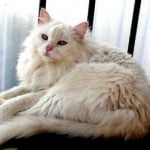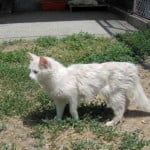
The origins and history of the Turkish Angora are interesting and perhaps a paradigm case of how all ‘discovered’ breeds started out and how many of the cat breeds still have their non-pedigree, non-purebred counterparts. The street cats that were the foundation cats of the discovered breeds are still there on the streets. They are the ‘real cat breeds’. Although ironically, technically speaking they are not cat breeds because they are moggies. The Egyptian Mau is another classic case. A breed yet to be created, the Bahraini Dilmun, is a further example.
The Turkish Angora (TA) has a long history and is a distinguished cat breed. It really should be more popular than it is. It has everything that the Maine Coon has. There are few breeders in the United States and the US is the biggest domestic cat market by far. I wonder why there are so few cat breeders? It is not an unpopular breed being ranked about 20th out of about 60 cats in this site’s long standing poll.
It has been suggested that the Turkish Angora (TA) originated from the wild cat the Manul (Pallas’s cat). Incidentally, Gloria Stephens in Legacy of the Cat (a fine book) gets this wrong by writing the “Manul cat..or Chinese desert cat…”
The Chinese desert cat is not the Manul. It is a subspecies of wildcat. But the wildcat is now considered certainly to be the wild ancestor of the domestic cat, specifically the African wildcat and/or Near Eastern Wildcat (African Asian wildcat). That takes us back to the beginning.
The above images copyright Angora Cat Association are thumbnails and can enlarged by clicking on them.
Jumping thousands of years forward we come to the street cats of Turkey. There are a range of moggies on the streets of Turkey. Some are and were bicolor cats and some were white cats. These are typical of places such as Turkey. There were, and still are, cat with a variety of other coat types on the street cats of Turkey. Tabbies are one example.
Some of the bicolor long-haired cats had unusual markings; an inverted V on the forehead and a colored tail but white elsewhere. These were chosen in the mid 1900s to become the Turkish Van. The white cat with the odd-eye color or blue eyes was chosen to become the Turkish Angora in the West (but see below). They both come from the same street cat, random bred, stock. They were separated and developed into distinct purebred, pedigree cats.
In the place of its ‘origin’, Turkey, the Turkish Angora is essentially a moggie, and a very attractive one. It is a fancy, purebred, ‘refined’ cat in the West. However, it is difficult to say that any one cat has an origin in one place. The domestic cat started in the Near East and spread from there. You can read about that process on this page.
This is where I would like to introduce what the Angora Cat Association in Turkey say about this famous cat. What they say counts. Firstly, they make the point that all the long-haired Turkish street cats, whatever their color, are ‘more or less’ Angoras. The Angora is a ‘breed of Turkish street cat’. They refer to the Turkish Angora as the “Angora”.
In Turkey not even the Turkish Angora is a pedigree, purebred cat. Even the special ones in the Ankara Zoo are moggies. The cats in the zoo are all whites (see pictures above). In Turkey, non-white long haired street cats are also treated as Angoras by many (not everyone, apparently). These non-purebred Angoras are more pure Turkish Angora than the highly selectively bred cats of American and Europe, in my opinion.
The Angora Cat Association in Turkey (ACA) say that the modern Turkish Angora in the West hardly looks the original cat. This is due to selective breeding to a ‘type’ (appearance) that is removed from the original. There was no attempt to maintain the original appearance. The selective breeding by breeders in the West is based on their preferences, what they think looks nice and interesting, not a desire to be faithful to the original. Also, the ACA make the point that the desire to expand a cat breed to include a wider range of coat types has resulted in the TA in the West having a pointed coat which is never seen in Turkey.
ACA make the interesting point that UC Davis Genome Project concluded that the current TA is genetically closer to the Egyptian Mau and cats in Tunisia than Turkish cats. The TA is a ‘mix of many cats’. This is classic random breeding. Although, I would suggest that despite that, the TAs in Ankara Zoo have a similarity of appearance that goes beyond just the white, longhaired coat. This would indicate to me that the street cats of Turkey or a segment of them have a particular genotype (genetic makeup) that expresses itself in what I consider to be the real Turkish Angora appearance.
Associated post: First we should know what Turkish, Turkish Angoras look like. And also see the page on the Angora cat.












This is my i believe to be Turkish angora I rescued from a horrible excuse of a human she’s dedicated smart and very very vocal and I’m lucky that she has chosen me to be her human.
To be clear, I understand the concept of “breed” only loosely applies to what we think a TA is.